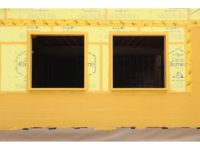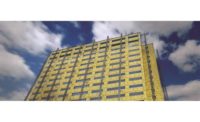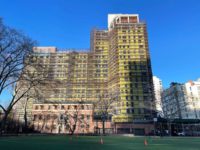From sleek glass facades to curved walls and balconies, modern building materials allow architects, designers, and engineers to execute some of the most impressive building designs the world has ever seen. If you can dream it, someone can build it.
The challenge comes when delivering on those dreams meets the reality of adhering to required building codes. Ultimately, the vision of a beautifully finished façade must be supported by properly installed substrates and control layers. Whether it be a mixed-use destination or a new corporate office, modern buildings incorporate unique angles, architectural accents, and multiple claddings for visual interest. These features place added demands on control layers that must accommodate a variety of geometries and penetrations.
With this in mind, designers and construction specifiers should look closely at opportunities to streamline both the production process and quality control of their wall assemblies. The ideal solution removes unnecessary installation steps by selecting sheathing panels with integrated water-resistive barriers and air barriers. These all-in-one materials help builders simultaneously achieve code compliance, shorten construction timelines, and simplify quality control for overall project success.
Air Barrier and Water Resistive Barrier Code Requirements
The IBC code requires both air barriers (AB) and water-resistive barriers (WRB) to be incorporated into wall assemblies. Simply put, these layers, along with continuous insulation, allow buildings to keep their occupants comfortable and dry in the most efficient way possible. At the same time, correct application of continuous control layers helps prevent buildings from experiencing a litany of water-related problems and helps prevent inefficient air movement between conditioned and unconditioned spaces. By controlling for water, air, and temperature, the result is a building that will perform well and retain its structural integrity for decades.
Individual air barrier materials are classified by meeting air permeance requirements of ASTM E2178, Standard Test Method for Air Permeance of Building Materials, while air barrier assemblies must meet requirements set forth in ASTM E2357, Standard Test Method for Determining Air Leakage of Air Barrier Assemblies. WRB testing for water penetration falls under ASTM D226, ASTM E331 and AATCC 127.
Beyond merely including these control layers in the wall assembly, as of the 2012 International Energy Conservation Code and 2012 International Building Code, respectively, ABs and WRBs must be continuous. If the control layers are interrupted, whether by rough openings, penetrations, or improper installation, the resulting discontinuities can create air and water leaks that compromise the entire building envelope's integrity. In order to achieve wall assemblies that will pass blower door tests (for air barriers) and ASTM E331 testing (for WRBs), builders and their installation crews must be diligent in properly installing their selected control layers and conducting quality control efforts throughout installation.
Pitfalls of Standard Control Layers
If all buildings were simple six-sided cubes, successfully installing continuous control layers would be easy. Using the popular “pen test,” building envelope designers would be able to draw an uninterrupted line around every face of the building to indicate seamless layers of control.
Unsurprisingly—and thankfully—most buildings aren't monolithic surfaces from foundation to rooftop. While the built environment gains great beauty from multidimensional facades, the pen test for these visually interesting designs becomes much more challenging to pass. Different adjacent substrates, penetrations, corners, and angles all invite the opportunity for building materials to move independently of each other. In these situations, achieving control layer continuity is much more difficult, and the air and water leakage caused by discontinuity become a real threat to building performance.
Case Study of a Continuity Complication
There are three historical material types that builders choose from when specifying AB and WRBs for their wall assemblies: building wraps, liquid- or fluid-applied materials, and self-adhered membranes. All three have their challenges:
· Building wraps install quickly but require careful and correct overlapping to prevent moisture intrusion, and can tear if not installed properly, and may have shorter exposure ratings than other materials, causing them to degrade more quickly.
· Fluid-applied membranes may roll or spray on easily, but must meet a prescribed thickness to be effective. If the application is too thin (apparent through voids and pinholes) air and moisture will be able to penetrate the barrier. Additionally, drying time is an important consideration.
· Self-adhered membranes solve the thickness issues of fluid-applied materials, but can be tricky to install. Some require priming before application to ensure good adhesion on all substrates. Like other adhesive materials, these membranes face challenges with wrinkles, fish mouths, air pockets, and puckering that invite areas for air and water to become trapped.
Weather can have further negative effects on the installation of each type of control layer. Building wraps may experience wind-related failures if not properly lapped and secured before cladding is installed. Temperature changes and precipitation can have negative effects on liquid WRBs by preventing a proper cure, and can similarly undermine self-adhered membranes by preventing a good adhesion. Builders and their installation crews must be careful to abide by manufacturers’ recommendations for optimal weather and temperature conditions during installation, and ensure that the substrate is clean and able to effectively receive the control material.
To further complicate the issue, standard WRB and AB materials often require installation crews to circle the building multiple times, depending on how many layers are required. Altogether, these steps can be challenging in unpredictable jobsite conditions. Every layer, and every trip around the building, and every round of quality control makes wall construction a tedious and time-consuming endeavor in an industry that is already spread thin from labor challenges.
Solving Control Layer Problems Takes Time & Money
Regardless of the material, the intricacies of standard air and water control layers can create a quality-control nightmare. Crews must carefully check each installed layer for gaps, tears, punctures, and other potential problems, and then take extra time to correct any errors. This is especially true when the control layer is a full assembly instead of just a single material.
Building Wrap
For example, if a building wrap is pulling double-duty as both WRB and AB under ASTM E2357, the onus is on installation crews to properly install the building wrap and the subsequent accessories for air tightness. Not only must installers add labor hours to the project from multiple trips around the building to achieve this, but the extensive lapping and taping is a challenging and inefficient method of achieving an air-tight seal. Alternatively, building envelope designers could move the air barrier to a different part of the structure, such as the interior of the building. But separating the control layers creates even more places to inspect for possible failures.
Fluid-Applied Materials
With fluid-applied and self-adhered membranes, installers must be ready to take on a multi-step process. The critical first step for both approaches is to ensure that the substrate is ready to receive the material. Dirt, oil, moisture including ice or frost, and any kind of bond-inhibiting material must be completely removed from the surface before proceeding. Again, this first quality control phase can be quite challenging and labor-intensive.
From there, installers using fluid-applied systems must protect all joints, openings, and other details with reinforcing mesh, tape, or liquid flashing, followed by another quality control check to ensure this step is executed correctly. Installers can then apply the fluid barrier material to cover every surface. Close attention to manufacturer’s instructions is essential. Installers will need to re-coat any thin spots in order to meet the required mil thickness, as well as any areas that may have been compromised by weather exposure before the first coat fully cured.
Self-Adhered Membranes
The same is true for self-adhered membranes. In addition to a clean surface, some SA membrane manufacturers may require application of a primer coat before applying the membrane to ensure it adheres properly. After application with a weighted roller, installers must carefully correct and patch any wrinkles, bubbles, fish mouths and other issues—another time-consuming quality control proposition. Both fluid-applied and self-adhered membranes can also have issues when bridging gaps at joints and seams on the substrates beneath. Using fabrics and other joint reinforcements in these instances is common, as is finishing the installation with termination mastics.
Each of these quality control measures costs time and money in the form of additional labor and, potentially, additional materials for re-coats, patches, or re-installation. But failure to take these steps is a dangerous game to play. Each mistake left uncorrected will be hidden and trapped in the building enclosure by subsequent layers, be it another control layer or the final cladding. At best, these hidden problems will keep each layer from achieving peak performance; at worst it will foster real problems that could lead to failure of the wall assembly.
Integrated WRB/AB Sheathing Solves Multiple Problems at Once
When modern building designs call for multiple substrates and complicated features or details, planning how to tackle wall assembly quality control can be daunting. Thankfully, specifiers have integrated sheathing products at their disposal that can streamline control layer installation so potential problems are all but eliminated.
Beginning with wood or gypsum panels, manufacturers in this product category use proprietary processes to produce sheathing panels that integrate WRBs and air barriers into the panel. When joints, seams and critical details are sealed and protected with system accessories it helps create a continuous building envelope. From the start, this approach simplifies building envelope installation by combining as many as three wall assembly components (sheathing, water-resistive barrier, and air barrier) into one familiar product.
And because the control layers are produced at the factory, specifiers and inspectors can be confident in the materials’ performance properties. Unlike field-installed control layers that are subject to human error and unpredictable jobsite conditions, sheathing with integral WRB-AB layers have a consistent thickness, should not delaminate or detach from the substrate under normal conditions, and are designed for compatibility with all other building envelope components. Moreover, factory production means builders can eliminate the additional quality control inspections that multi-step building envelope installation demands. Rather than taking extra time for quality control after surface prep, joint reinforcement, and material installation, integrated WRB/AB sheathing calls for just one round of inspection as part of the installation process.
Installing integrated WRB/AB panels is as easy as installing standard sheathing, and requires no special skills, tools, or fasteners. But as mentioned earlier, all building designs present construction teams with challenges around angles, penetrations, and other design elements. With that in mind, most integrated WRB-AB manufacturers offer a selection of accessories, including liquid flashing and transition membranes. In addition to creating the required continuous control layer required by code, these complementary materials help installers easily handle any gaps, joints and seams. Unlike standard WRB-AB materials, using an integrated WRB/AB sheathing panel ensures that installers need only address those tricky situations once—not multiple times with each successive control layer.
Accessory materials also give builders a valuable element of built-in quality control. Installers can flash and seal fasteners and transitions as they go, creating code-required continuous water-resistive and air barriers and easily spotting any areas that were missed. Since the sheathing and control layers are installed all at once with confidence, builders can save themselves the labor and materials involved in re-inspecting and repairing problem areas that come with standard building envelope installation.
Integrated WRB-AB sheathing systems combine the strength and structural integrity of sheathing with factory-applied WRB/AB technology that will accommodate even the most creative building designs. With the speed of building wrap, the ease of fluid-applied materials, and the consistent mil thickness of self-adhered membranes, WRB-AB integrated panels combine the best features of standard products, while building quality control directly into the installation process. The result is one supremely efficient trip around the building. By simplifying the design and installation of the building envelope, builders can ensure their projects look beautiful and perform beautifully.
For more information, visit https://buildgp.com/denselement/system/installation/






